 Photos (and drawings) provided by Susan and Ryan Hayes.A couple builds a smaller, affordable, “green” house
Photos (and drawings) provided by Susan and Ryan Hayes.A couple builds a smaller, affordable, “green” house
When I called Susan Hayes to talk to her about her new, affordable, “green” house in Williston, Vermont, one of the first things she said was, “We really wanted to respect the local vernacular…” She and her husband Ryan created what they call a “Modern Farmhouse”. The exterior was inspired by the farmhouse Ryan’s dairy-farming great grandparents’ owned, and “the inside is really sparse which is more of a Modern feel,” explains Susan. Their hybrid aesthetic is unusual for a “green” home. The fact that it’s smaller is a “green” hallmark.
Smaller and greener
I found Susan and Ryan through their blog Building Green in Vermont in which they've documented their home’s “green” evolution.  “We really weren’t that enlightened when we started,” admits Susan. But thanks, in part, to a lengthy local permitting process, they had time to research and educate themselves in efficient and sustainable design. Susan discovered that “size is absolutely critical.” After estimates for an initial design proved too expensive, she and Ryan realized they would need to downsize to keep the construction of their first house on budget and “green”. They scrapped plans for a 2200 sq. ft house (not including a finished, walk-out basement) for a 1568 sq. ft house (not including a finished, walk-out basement).
“We really weren’t that enlightened when we started,” admits Susan. But thanks, in part, to a lengthy local permitting process, they had time to research and educate themselves in efficient and sustainable design. Susan discovered that “size is absolutely critical.” After estimates for an initial design proved too expensive, she and Ryan realized they would need to downsize to keep the construction of their first house on budget and “green”. They scrapped plans for a 2200 sq. ft house (not including a finished, walk-out basement) for a 1568 sq. ft house (not including a finished, walk-out basement).
The initial larger scheme had been created by a drafting service under Susan and Ryan’s direction. The smaller scheme, which they built, was based on an architectural design they found online by an architect in South Carolina. 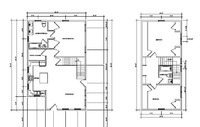 “I’m a big fan of Sarah Susanka. When you’re designing small, I think you really need an architect,” notes Susan. “What the architecturally designed plan did for us was create a more thoughtful house,” she concludes. Reducing approximately 630 sq. ft. from the first and second floors ultimately brought the house’s construction costs down to around
“I’m a big fan of Sarah Susanka. When you’re designing small, I think you really need an architect,” notes Susan. “What the architecturally designed plan did for us was create a more thoughtful house,” she concludes. Reducing approximately 630 sq. ft. from the first and second floors ultimately brought the house’s construction costs down to around 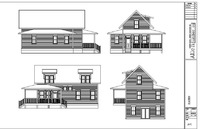 $235,000. That figure doesn’t include the land, which had been in Ryan’s family, or the site work and consultants’ fees. Also, Susan and Ryan may have saved money by handling the bulk of the general contracting themselves prior to breaking ground. Once construction began, they happily handed much of the general contracting responsibility over to Bill Litchfield of Specialty Design.
$235,000. That figure doesn’t include the land, which had been in Ryan’s family, or the site work and consultants’ fees. Also, Susan and Ryan may have saved money by handling the bulk of the general contracting themselves prior to breaking ground. Once construction began, they happily handed much of the general contracting responsibility over to Bill Litchfield of Specialty Design.
Investment in building envelope and systems
“The stuff we spent the most money on is the stuff you’ll never see…and the exterior piece,” says Susan. 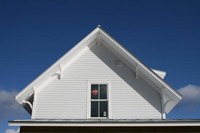 She and Ryan invested in ICFs (Insulated Concrete Forms) for the basement, SIPs (Structurally Insulated Panels) for the exterior walls, closed-cell blown-in insulation for the truss roof, fiberglass windows, fiber cement lap siding, a propane-fired radiant heating system, an HRV (Heat Recovery Ventilator), and standing-seam metal roofing. They have future plans to install solar panels on the property to incorporate into the heating and/or domestic hot water systems. Susan continues, “…We definitely were willing to make compromises on interior finishes that we were not willing to make on the building envelope.”
She and Ryan invested in ICFs (Insulated Concrete Forms) for the basement, SIPs (Structurally Insulated Panels) for the exterior walls, closed-cell blown-in insulation for the truss roof, fiberglass windows, fiber cement lap siding, a propane-fired radiant heating system, an HRV (Heat Recovery Ventilator), and standing-seam metal roofing. They have future plans to install solar panels on the property to incorporate into the heating and/or domestic hot water systems. Susan continues, “…We definitely were willing to make compromises on interior finishes that we were not willing to make on the building envelope.”
Interior simplicity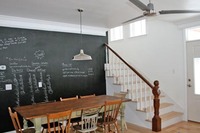 The interior, however, did not suffer as a result. The primary living spaces are clean, mostly white with sustainably harvested maple floors from a nearby Canadian supplier. Susan and Ryan splurged on zero V.O.C. paint, custom kitchen cabinetry, solid-surface counters made with 100% post-consumer recycled paper, and stainless steel
The interior, however, did not suffer as a result. The primary living spaces are clean, mostly white with sustainably harvested maple floors from a nearby Canadian supplier. Susan and Ryan splurged on zero V.O.C. paint, custom kitchen cabinetry, solid-surface counters made with 100% post-consumer recycled paper, and stainless steel 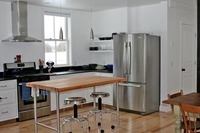 Energy Star-qualified kitchen appliances. When funds allow, they may swap out the porcelain ceramic tile at the entry with large slate tiles. Other features, like the black-board paint on the dining area wall, hexagonal floor tile and subway wall tile in the bathrooms, as well as reclaimed bathroom sinks add character relatively inexpensively. Over time, they expect to add punches of interior color in keeping with their taste for Scandinavian design.
Energy Star-qualified kitchen appliances. When funds allow, they may swap out the porcelain ceramic tile at the entry with large slate tiles. Other features, like the black-board paint on the dining area wall, hexagonal floor tile and subway wall tile in the bathrooms, as well as reclaimed bathroom sinks add character relatively inexpensively. Over time, they expect to add punches of interior color in keeping with their taste for Scandinavian design.
Green research
Susan and Ryan learned about “green” building with the aid of consultants and resources like Efficiency Vermont (a nonprofit provider of energy efficiency services in Vermont) and by taking it upon themselves to explore “green” design in magazines, museums, at conferences, and online, especially through blogs. 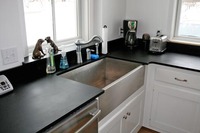 They found two blogs particularly influential, the 100K House and From the Ground Up. “Reading blogs was absolutely ideal. That’s why we started ours because I learned so much from other people that were going through the process,” says Susan. “The blog became my virtual binder…It was a really nice way for me to catalog the research…” she continues.
They found two blogs particularly influential, the 100K House and From the Ground Up. “Reading blogs was absolutely ideal. That’s why we started ours because I learned so much from other people that were going through the process,” says Susan. “The blog became my virtual binder…It was a really nice way for me to catalog the research…” she continues.
Advice for other homeowners
For those about to embark on the affordable “green” house design process, Susan summarizes, “Go small. I don’t think we could have achieved the efficiencies that we did had it been a larger house. Prioritize the building envelope…Put the things that effect efficiency first and foremost.”  She’s also aware of the temptation toward the end of a construction project to wander off course. “I feel like if you’re gong to pull off going ‘green’ on a budget, you kind of have to identify the non-negotiables and really hold fast to them,” she says. Susan and Ryan kept reminding themselves of their project goals and, she explains, “We really stuck to our guns.”
She’s also aware of the temptation toward the end of a construction project to wander off course. “I feel like if you’re gong to pull off going ‘green’ on a budget, you kind of have to identify the non-negotiables and really hold fast to them,” she says. Susan and Ryan kept reminding themselves of their project goals and, she explains, “We really stuck to our guns.”
Future projects
With their home’s construction mostly behind them, Susan and Ryan have a new adventure on the horizon. 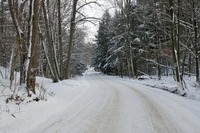 Their snowy road.They’re expecting their first child in February. Though their attention is likely to stray from “green” building for a time, come spring they hope to cultivate an edible landscape which they intend to water with rain collected in barrels from the roof. They started last fall by planting an orchard of Macintosh, Liberty, and Sweet Sixteen apple trees, and they plan to add raspberry and blueberry bushes elsewhere. According to Susan, “I really like long-term projects.” If you’re building “green”, a long-term mindset certainly helps.
Their snowy road.They’re expecting their first child in February. Though their attention is likely to stray from “green” building for a time, come spring they hope to cultivate an edible landscape which they intend to water with rain collected in barrels from the roof. They started last fall by planting an orchard of Macintosh, Liberty, and Sweet Sixteen apple trees, and they plan to add raspberry and blueberry bushes elsewhere. According to Susan, “I really like long-term projects.” If you’re building “green”, a long-term mindset certainly helps.
by Katie Hutchison for House Enthusiast and Small House Style. If you like the Hayes' house, you may be interested in the predesigned houses Katie Hutchison Studio is developing which will accommodate today’s full lives in smaller, high-performance homes inspired by vernacular simplicity. Stay tuned.

